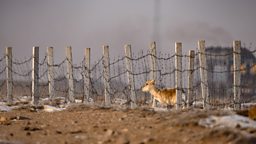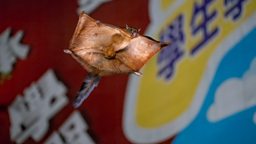Finding hope: Panji and the Javan green magpie
By Lucy Bailey, Producer / Director

Finding the perfect story for an audience is not easy. It’s always going to need a lot of research work, a talented crew working together using their instincts, and of course often a stroke of luck. This was exactly the case when it came to finding and filming the story of the Javan green magpie that we feature in Asia’s conservation episode, Saving Asia.
In central Java this trade means that many songbirds are now threatened with extinction...
We wanted to make this episode feel very much in the moment, capturing real-life situations as they evolved in real time as much as possible – very different from the more flawless, picture-perfect, slow-motion images usually seen in traditional natural history films.
We wanted to cover the fact that forests across Indonesia are falling silent because of the trend for keeping songbirds as pets in cages, a hobby that has escalated to new heights with bird singing competitions that take place all across the country. In central Java this trade means that many songbirds are now threatened with extinction, taken from their forest homes to be sold as part of the illegal wildlife trade.

How could we tell this story in a meaningful way, so that the audience could relate to the characters and issues? Could a scenario that’s so bleak become one that is watchable, that we could all learn something from? That was the challenge.
...Panji’s work requires a deep understanding of the local culture...
My Assistant Producer, Billy Clapham, began to focus on the work of a superb Javan field biologist, Panji Gusti Akbar, who is endeavouring to save the Javan green magpie, one of the rarest birds in the world. Panji and the conservation team at the Cikananga Wildlife Centre are caring for the last few of the species that remain in Java, trying to breed these extraordinary birds in captivity to ultimately be able to release a viable population back into the wild. However, there is currently no safe habitat where they won’t be poached again, so Panji’s work requires a deep understanding of the local culture to shift people’s perceptions – to help them value the birds in their natural environment, and not in cages.
We thought about filming someone who makes an income from prize-winning songbirds and asked our brilliant fixer, Rofiana Aan, to ask around and see if that might be possible. She soon arranged for us to meet a man who reportedly owned many songbirds, where we hoped to film Panji trying to understand the bird trade from the perspective of somebody who depended on it to make a living.

As we entered Mr Neo’s property none of us knew what to expect, but his house was full of award-winning songbirds of many colours, shapes and sizes. Crammed into every room were cages, even the kitchen and bathroom contained popular species of prized birds from floor to ceiling. But to our utter astonishment, at the back of the property there was a small cage containing a Javan green magpie.
...we weren’t sure quite how the owner would react as Panji told him of the rarity of this particular bird.
We exchanged nervous glances with Panji, and with lumps in our throats just kept filming as Panji chatted with Mr Neo about all the birds. With eye contact alone we signalled to each other and kept rolling as Panji eventually gently asked about the Javan green magpie, and queried how the bird had ended up there. We were quite apprehensive; we weren’t sure quite how the owner would react as Panji told him of the rarity of this particular bird. It’s thought there could be as few as fifty left in the wild.
Neither I nor my Director of Photography, Andrew Thompson, spoke a word of Bahasa, but we instinctively knew what was being captured on camera. It’s a remarkable moment when Mr Neo realises that he has such a critically endangered bird in his custody.

That evening, after filming finished, we still couldn’t quite believe that there was a Javan green magpie in a house in a suburban street in Yogyakarta. Although it wasn’t in our original plan, we made the decision with Panji that we must invite Mr Neo with us for the next day’s filming, where we were visiting a conservation project that’s been a big inspiration for Panji.
...the sheer joy and delight in Mr Neo’s face as for the first time he saw the birds in their natural environment.
At Jatimulyo village, ex-poachers have become nest protectors, and tourists and photographers flock from across Asia for the opportunity to capture photographs of wild birds. Tourism financially supports the whole village, and its residents take pride in the fact they live alongside rare birds, and see the value of keeping songbirds firmly in the wild. We put Mr Neo alongside a group of top bird photographers, and a little bit of magic happened.
We were able to film the sheer joy and delight in Mr Neo’s face as for the first time he saw the birds in their natural environment. And he realised that there are alternative ways of making a living from birds, still loving them of course, but just appreciating them in a different way.

It is very special capturing a once-in-a-lifetime moment like this on camera, where the penny drops, and the dial shifts – it’s like seeing conservation happen in real time. Straight away Mr Neo agreed to give his Javan green magpie to Panji’s breeding centre at Cikananga. A shift in perception, in understanding, is all it takes to make things better. Change can sometimes happen in an instant, albeit just one person at a time.
It’s not often that being there as a film crew really makes a difference for the better, but on this occasion it did.
So, just like that, two percent of the population of the rarest and most beautiful bird was given a new lease of life; to help save its species in the breeding programme, and in the future to once again have the opportunity of living free in the wild, but cared for and protected by the local population, just as it should be.
It was a wonderful coming together of Panji the dedicated conservationist, a hard-working film team, and an incredible character as a contributor. It’s not often that being there as a film crew really makes a difference for the better, but on this occasion it did.
At times during the making of this conservation episode it was quite depressing to realise and experience first-hand the extent of the biodiversity loss across Asia, but we found, and filmed, hope in all our stories. Fingers crossed the audience loves this real-life tale of transformation as much as we do.

Saving the Javan green magpie
A critically endangered bird finds hope as locals shift from poaching to conservation.



































